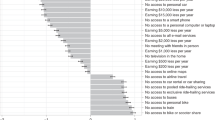Abstract
During the last \(40\) years, a large number of studies have analyzed car holding and use behavior. Most of these ignore the dynamics of household and driver needs that very likely drive such decisions. Our work builds up on a disaggregate (compensatory) approach using revealed choices to address these dynamics. We develop a dynamic discrete/continuous choice model of car holding duration for forward-looking agents. We estimate this model using French panel survey data. Our findings indicate that a household’s time preference is a crucial element in car use and holding decisions.

Similar content being viewed by others
Notes
With a slight abuse of definition, we will use the term fleet in this paper to indicate the stock of cars that an household owns.
If a new car enter in the household’s fleet this is accounted in the fleet size and a new decision process starts for this new vehicle.
It is known that the normality assumption is not adapted for income.
We acknowledge that the hypothesis of normal errors, proposed in the literature, is more credible for the considered problem. However, as probit results are generally proportioned to the logit ones and the latter interpretation is easier than the former, the errors here are considered as logistic.
We suggest that it is not completely true. When a single-vehicle household chooses to scrap its sole vehicle, it effectively chooses to end its motorization. Thus, the household can consider that its inclusion in the panel is no longer useful for the survey’s purpose and exit, thereby causing non-random attrition.
The reader may contact the authors whenever he/she desires to obtain any of the estimated transition matrices regarding fuel prices.
References
Adda, J., & Cooper, R. (2000). Balladurette and juppette: a discrete analysis of scrapping subsidies. Journal of Political Economy, 108(4), 778–806.
Aguirregabiria, V., & Mira, P. (2010). Dynamic discrete choice structural models: a survey. Journal of Econometrics, 156(1), 38–67.
Baron, J.-F. (2002). La consommation automobile depuis quarante ans. INSEE Première, 844, 1–4.
Bellman, R. (1957). Dynamic programming. Princeton: Princeton University Press.
Bento, A. M., Goulder, L. H., Jacobsen, M. P., & von Haefen, R. H. (2009). Distributional and efficiency impacts of increased us gasoline taxes. American Economic Review, 99(3), 667–699.
Berkovec, J., & Rust, J. (1985). A nested logit model of automobile holdings for one vehicle households. Transportation Research Part B, 19(4), 275–285.
Bertsekas, D. P. (2000). Dynamic programming and optimal control (2nd ed.). Belmont: Athena Scientific.
Bhat, C. (1994). Imputing a continuous income variable from grouped and missing income observartions. Economics Letters, 46(4), 311–320.
Bhat, C., & Sen, S. (2006). Household vehicle type holdings and usage: an application of the multiple discrete-continuous extreme value (mdcev) model. Transportation Research Part B, 40(1), 35–53.
CCFA. (2006). Analyse et statistiques. Comité des Constructeurs Français Automobiles.
de Jong, G. (1990). An indirect utility model of car ownership and private car use. European Economic Review, 34, 971–985.
de Jong, G. (1996). A disaggregate model system of vehicle holding duration, type choice and use. Transportation Research Part B, 30(4), 263–276.
de Jong, G., & Gunn, H. (2001). Recent evidence on car cost and time elasticities of travel demand in europe. Journal of Transport Economics and Policy, 35, 137–160.
de Jong, G., & Kitamura, R. (2009). A review of household dynamic vehicle ownership models: holdings models versus transactions models. Transportation, 36, 733–743.
Gilbert, C. (1992). A duration model of automobile ownership. Transportation Research Part B, 26, 97–114.
Goodwin, P. (1992). A review of new demand elasticities with special reference to short and long run effects of price changes. Journal of Transport Economics and Policy, 26, 155–163.
Graham, D., & Glaister, S. (2002). The demand for automobile fuel: A survey of elasticities. Journal of Transport Economics and Policy, 36, 1–26.
Graham, D., & Glaister, S. (2004). Road traffic demand elasticity estimates: A review. Transport Reviews, 24(3), 261–274.
Hensher, D. A., Milthorpe, F. W., & Smith, N. C. (1990). The demand for vehicule use in the urban household sector. Journal of Transport Economics and Policy, 24(2), 119–137.
Hocherman, I., Prashker, J. N., & Ben-Akiva, M. (1983). Estimation and use of dynamic transaction models of automobile ownership. Transportation Research Records, 944, 134–141.
Julliard, M. (2007). Le budget automobile des ménages s’adapte aux prix des carburants. INSEE Première, 1159, 1–4.
Magnac, T., & Thesmar, D. (2002). Identifying dynamic discrete decision processes. Econometrica, 70, 801–816.
Mannering, F. (1983a). Dynamic econometric models of car ownership and utilization. PhD Thesis, Massachusetts Institute of Technology
Mannering, F. (1983b). An econometric analysis of vehicle use in multivehicle households. Transportation Research Part A, 17(3), 183–189.
Rust, J. (1987). Optimal replacement of GMC bus engines: An empirical model of Harold Zurcher. Econometrica, 55(5), 999–1033.
Rust, J. (1996). Numerical dynamic programming in economics. In H. M. Amman, D. A. Kendrick, & J. Rust (Eds.), Handbook of computational economics (Vol. 1, Chap. 14, , pp 619–729). Amsterdam: Elsevier.
Stewart, M. (1983). On least squares estimation when the dependent variable is grouped. Review of Economic Studies, 50, 141–149.
Terza, J. (1985). Ordered probit: A generalization. Communications in Statistics? A Theory and Methods, 14, 1–11.
Train, K. (1986). Qualitative choice analysis: Theory, econometrics, and an application to automobile demand. Cambridge: MIT Press.
Turrentine, T. S., & Kurani, K. S. (2007). Car buyers and fuel economy. Energy Policy, 35, 1213–1223.
Xu, R. (2011). Dynamic discrete choice models for car ownership modeling. PhD Thesis, Department of Civil and Environmental Engineering, University of Maryland.
Acknowledgments
We gratefully thank Maria Kuecken, University of Paris 1 Panthéon-Sorbonne/Paris School of Economics, for her remarks and suggestions.
Author information
Authors and Affiliations
Corresponding author
Rights and permissions
About this article
Cite this article
Cernicchiaro, G., de Lapparent, M. A Dynamic Discrete/Continuous Choice Model for Forward-Looking Agents Owning One or More Vehicles. Comput Econ 46, 15–34 (2015). https://doi.org/10.1007/s10614-014-9449-4
Accepted:
Published:
Issue Date:
DOI: https://doi.org/10.1007/s10614-014-9449-4




